#105; .
Explore tagged Tumblr posts
Text
I'm so thirsty I could drink- R E N H A N A B O D Y P I L L O W N I P P L E C O L O R :
HEX #b87669
HSL 10, 36, 57
RGB 184, 118, 105
ΧΥΖ 29, 24, 17
CMYK 0, 36, 43, 28
LUV 56,58,20,
LAB 56, 24, 18
HWB 10, 41, 28
26 notes
·
View notes
Text
mulloey’s 2k celebration



UPDATE: SUBMISSIONS CLOSED!!! expect a response for your prompts soon ;)
thank you so much for 2k followers🖤!! i love all you little freaks
i wasn’t quite sure how to celebrate this, but i’ve seen a few people do prompt games before so i’ve decided to do one too! i’ll try my best to answer every prompt i receive, so feel free to participate!
info is below the cut!!
the rules
send me an ask with the prompts you’d like to see (multiple are allowed!) and the idol(s) you’re requesting. you can request anyone from ateez, nct (127, dream, wayv), exo, seventeen and skz. multiple partners are allowed. these will be shorter drabbles rather than full fics. feel free to specify any specific ideas with the prompts, or feel free not to!
the prompts
kinks:
101. cnc
102. exhibitionism
103. filming/sex tapes
104. humiliation
105. size kink
106. somnophilia
107. punishment
108. orgasm denial/edging
109. overstimulation
110. sensory deprivation
111. pet play
112. roleplay
113. daddy kink/ddlg (no sexual age play)
114. bdsm
115. spanking/impact play
116. public sex
117. cuckolding
118. knife play
119. hypnotism
120. wax play
121. bondage
122. double/triple penetration
123. oral (f receiving)
124. oral (m receiving)
125. deepthroating/face fucking
126. anal
127. corruption
128. collaring
129. omorashi/bathroom control
130. bimbofication/objectification
131. choking
132. dacryphilia
133. dick worship
134. gags
135. sadism/masochism
136. breeding
137. phone sex
scenarios:
201. non-au
202. hookups
203. bdsm club
204. a/b/o
205. teacher/student
206. office workers
207. strip club
208. royalty
209. magic
210. hybrids
211. dystopian
212. serial killer
213. dark/dead dove
214. neighbours
215. fwb
216. college
217. tattoo shop
218. power imbalance
219. idol x idol
220. idol x fan
221. rock/band au
222. idol x company worker
223. arranged marriage
224. fake dating
225. mafia/crime
226. cult
227. vampires
228. rivals
dialogues:
301. “you think you deserve that?”
302. “i know you’ve been watching me”
303. “seems we have an audience”
304. “hands behind your back”
305. “don’t look at them, they’re not gonna help you”
306. “look at you taking it”
307. “you’re all messy, baby”
308. “what did you say?”
309. “do you need a reminder?”
310. “i’m not done with you”
311. “i’m taking you home”
312. “louder. i wanna hear you”
313. “show me”
314. “she’s always sensitive. aren’t you, baby?”
315. “this is what you fantasised about, right?”
316. “i said you had my permission. i never said i’d help you”
317. “remember what i taught you? let me see”
318. “i want you sore”
319. “louder.”
320. “come here”
321. “that’s what i thought”
322. “who’s in charge here?”
323. “you can’t hide. not from me”
324. “i love you like this”
325. “you know what to say”
326. “you know what to call me”
327. “i’ve got you.”
—
feel free to include anything else, but i cannot guarantee that i’ll be able to include it! can’t wait to see your answers :p
#ateez smut#svt smut#seventeen smut#skz smut#exo smut#nct smut#nct 127 smut#nct dream smut#wayv smut
40 notes
·
View notes
Text



Hootz-Tsik, a Dish in the Bear's Nest
Augustus Bean and Rudolph Walton
from the website: Feast dishes played an important role in historic Northwest culture. Often elaborately carved and decorated, they were important heirlooms and an essential component in ceremony proclaiming social status and clan affiliation, and relaying traditional narratives. Bowls among the Tlingit sometimes bore individual names, and themselves could be subject to stories and histories documented in ritual and song.
By the late nineteenth century, European and Euro-American incursion on the Coast resulted in changes to traditional practices, and in the separation of countless heirlooms from their associated names and stories. Within this shifting environment, individuals found ways of documenting and adapting tradition, as is evident here in this remarkable Tlingit feast bowl, one of a number of examples identified as the work of Augustus Bean, and his brother-in-law Rudolph Walton.
High-ranking members of Sitka families and respected leaders in their community, both Bean and Walton are remembered for their challenges to American legal authorities, contribution to the so-called ‘Last Potlatch’ of 1904, and for carving objects for ritual and ceremonial use, and traditionally informed objects for sale to Euro-American collectors and institutions. [1]
In 1926 Rudolph Walton said of a “Hootz-tsik” or bear feasting bowl closely related to the present example and acquired from the artist by the Sheldon Jackson Museum in Sitka, Alaska: “This is the kind of dish the old hunter used. His name was Kotz. Long time ago he was captured by the Bears and married into the Bear tribe. Later on he had sons and daughters, half men, half bear. This kind of dish he used, a dish in the Bear’s Nest.” [2]
The present bowl’s first known owner was Admiral Charles H. Rockwell (1840-1908). [3] Rockwell was stationed in Sitka as Lieutenant Commander of the U.S.S. Jamestown, the sole American administrative body in the region between 1878 and 1884. [4] Augustus Bean and the younger Rudolph Walton were both well known to Navy and government representatives in the region as early as 1894 and would have been in close proximity to Rockwell during his stay in the region when the present bowl was likely sold or gifted to him. [5]
Related Works: Saint Louis Art Museum, Col. No. 275:1982. Click here to read more British Museum, Col. No. Am1976,03.12. Click here to read more Alaska State Museum, Col. No. II-B-1010—see: Jones, Zachary R. “Haa Leelk’w Has Ji.Eeti, Our Grandparents’ Art: A Study of Master Tlingit Artists, 1750-1989,” PdD. Dissertation, University of Alaska Fairbanks, 2018. P. 133, pl. 119-129, p. 135, pl. 121
(1) Zachary R. Jones, “Haa Leelk’w Has Ji.Eeti, Our Grandparents’ Art: A Study of Master Tlingit Artists, 1750-1989,” PdD. PdD. Dissertation University of Alaska Fairbanks, 2018. p. 129-135 and 163-171 (2) Joyce Walton Shales, “Rudolph Walton: One Tlingit Man’s Journey Through Stormy Seas Sitka, Alaska, 1867-1951.” PhD. Thesis, University of British Columbia, 1998. p. 105 Click here to read more (3) Gailia Mackenzie (Great Granddaughter of Admiral Charles H. Rockewell), letter to John Livingston, March 9, 2015. (4) Robert D.B. Carlisle, Chatham’s Admiral, Charles H. Rockwell, (Chatham: Stage Neck Publications, 2002), 127. (5) Jones, 130.
43 notes
·
View notes
Text
Cosmere characters alphabet survey - results
So, as some of you remember, a short time ago I ran this survey:
It's closed now, but as promised, I am posting the results. This post is only the top three characters for letter, so if you want the detailed statistics with all the characters, funny jokes and a lot more data, click here.
A
🥇 Adolin - 160 votes
🥈 Adonalsium - 17
🥉 Adonalsium-Will-Remember-Our-Plight-Eventually - 13
B
🥇 Breeze - 72
🥈 Ba-Ado-Mishram - 48
🥉 Battar - 21
C
🥇 Clubs, Chanarach - 33
🥈 Cett, Cephandrius - 24
🥉 Charlie - 19
D
🥇 Dalinar - 143
🥈 Demoux - 22
🥉 Dockson - 19
E
🥇 Elend - 93
🥈 Evi - 49
🥉 Eshonai - 38
F
🥇 Felt - 67
🥈 Fen - 44
🥉 Frost - 11
G
🥇 Gavinor - 67
🥈Gavilar - 49
🥉Galladon - 43
H
🥇 Hoid - 91
🥈 Hrathen - 54
🥉 Ham - 40
I
🥇 Ialai - 101
🥈 Ishar - 31
🥉 Iyatil - 30
J
🥇 Jasnah - 172
🥈 Jezrien - 19
🥉 Jakamav - 13
K
🥇 Kaladin - 150
🥈 Kelsier - 57
🥉 Kalak - 11
L
🥇 Lift - 46
🥈 Lirin - 45
🥉 Lightsong - 35
M
🥇 Moash - 53
🥈 Marasi - 48
🥉 Marsh, MeLaan - 34
N
🥇 Navani - 76
🥈 Nale - 39
🥉 Nohadon - 38
O
🥇 Oroden - 78
🥈OreSeur - 59
🥉Odium - 67
P
🥇 Pattern - 63
🥈 Palona - 30
🥉 Painter - 28
Q
🥇 Quellion - 57
That's it for Q
R
🥇 Renarin - 66
🥈 Raoden - 51
🥉 Rysn - 26
S
🥇 Shallan - 51
🥈 Steris - 30
🥉 Sarene - 29
T
🥇 Tress - 45
🥈 TenSoon - 39
🥉 Teft - 38
U
🥇 Ulaam - 105
🥈 Ulim - 31
🥉Uli Da - 9
V
🥇 Vin - 107
🥈 Vivenna - 39
🥉 Venli, Vasher- 35
W
🥇 Wayne - 82
🥈 Wax - 75
🥉 Wyndle - 25
X
🥇 Xisis - 74
🥈 Xorm - 6
That's it for X)
Y
🥇 Yumi - 86
🥈 Yanagawn - 35
🥉 Yalb - 20
Z
🥇 Zahel - 80
🥈 Zane - 63
🥉 Zellion - 52
16 notes
·
View notes
Text
SOA supplementals
Primary Sources / Letters
Papers of George Washington RevWar Series volume 11 (all)
The Army Correspondence of Colonel John Laurens in the Years 1777-1778 compiled by William Gilmore Simms (p.145-162)
The Papers of Henry Laurens volume 13 (p.33-140)
The Political Writings of Alexander Hamilton by Holloway and Wilson (p.7-117)
Backstory / additional context
The First Conspiracy by Brad Meltzer and Josh Mensch (all)
The Great New York Fire of 1776: A Lost Story of the American Revolution by Benjamin Carp (all)
Kidnapping the Enemy by Christian M. McBurney (all)
Strategy, Politics, Staff
Fatal Sunday by Lender and Stone (p.xi-122)
Washington's Secret War by Thomas Fleming (all: p.223-244)
To Starve the Army at Pleasure by E. Wayne Carp (various)
The Valley Forge Winter by Wayne Bodle (all: p.163-220)
George Washington's Indispensable Men by Arthur Leftkowitz (p.15, 45-157)
John Laurens and the American Revolution by Gregory Massey (p.86-106)
Washington's General: Nathaniel Greene and the Triumph of the American Revolution by Terry Galloway (p.165-171)
Wives / Women of the Army
Founding Mothers: The Women Who Raised Our Nation by Cokie Roberts (various)
The General & Mrs Washington by Bruce Chadwick (p.209-222)
Martha Washington: An American Life by Patricia Brady (p.118-126)
Caty: A Biography of Catherine Littlefield Greene by John & Janet Stegeman (p.48-59)
Pox Americana by Elizabeth Fenn (p.98-103)
Spies
Revolutionary Spies Intelligence and Espionage in America's First War by Tim McNeese (p.99-209)
General Washington's Spies on Long Island and in New York by Morton Pennypacker (p.1-119)
Washington's Spies by Alexander Rose (all)
Spies in the Continental Capital by John Nagy (all)
George Washington's Secret Spy War: The Making of America's First Spymaster by John Nagy (all)
Allies / foreign officers / special forces
Unlikely Allies: How a Merchant, a Playwright, and a Spy Saved the American Revolution by Joe Richard Paul (all)
Thomas Paine: Enlightenment, Revolution, and the Birth of Modern Nations by Craig Nelson (p.99-145)
Special Operations During the American Revolution by Robert Tonsetic (p.7-149)
Light Horse Harry: A Biography of Washington's Great Cavalryman by Noel B. Gerson (p.1-60)
John Paul Jones: Sailor, Hero, Father of the American Navy by Evan Thomas (p.97-133)
The Admiral and the Ambassador by Scott Martelle (p.49-54)
Tadeusz Kościuszko and Casimir Pulaski: The Lives of the Revolutionary War's Most Famous Polish Officers by Charles River Editors (Pulaski section)
Pulaski: A Portrait of Freedom by R.D. Jamro (p.85-99)
Steuben / Drill
The Drillmaster of Valley Forge by Paul Lockhart (p.105-113)
The Life of Von Steuben by Frederich Kapp (p.120-136)
Baron Von Steuben's Revolutionary Drill Manual: A Facsimile Reprint of the 1794 Edition (all)
Lafayette
For Liberty and Glory: Washington, Lafayette and Their Revolutions by James R. Gaines (p.98-106)
Adopted Son by David Clary (p.154-179)
Lafayette by Harlow Giles Unger (p.65-71)
The Marquis: Lafayette Reconsidered by Laura Auricchio (p.59-64)
#idk if I wanna tag this as sources#because it's not an exhaustive list- just the physical books#Chapter 19#this is mostly a reference for me#but figured I'd share as a rec for people looking for titles
34 notes
·
View notes
Text

>>> Collection Leather Smokers | B&W
#105
[ > Models smoke : Luciano P ]
#cuirsmokersnb#cuirsmokers#smokingmodels#smokingmodelsnb#luciano p#cigarette#smokingguys#smokingguysnb
28 notes
·
View notes
Text
Interesting Papers for Week 17, 2025
A spatial code for temporal information is necessary for efficient sensory learning. Bagur, S., Bourg, J., Kempf, A., Tarpin, T., Bergaoui, K., Guo, Y., Ceballo, S., Schwenkgrub, J., Verdier, A., Puel, J. L., Bourien, J., & Bathellier, B. (2025). Science Advances, 11(2).
Beyond nature, nurture, and chance: Individual agency shapes divergent learning biographies and brain connectome. Barde, W., Renner, J., Emery, B., Khanzada, S., Hu, X., Garthe, A., Rünker, A. E., Amin, H., & Kempermann, G. (2025). Science Advances, 11(2).
Dynamics of specialization in neural modules under resource constraints. Béna, G., & Goodman, D. F. M. (2025). Nature Communications, 16, 187.
Discretized representations in V1 predict suboptimal orientation discrimination. Corbo, J., Erkat, O. B., McClure, J., Khdour, H., & Polack, P.-O. (2025). Nature Communications, 16, 41.
Cortical direction selectivity increases from the input to the output layers of visual cortex. Dai, W., Wang, T., Li, Y., Yang, Y., Zhang, Y., Wu, Y., Zhou, T., Yu, H., Li, L., Wang, Y., Wang, G., & Xing, D. (2025). PLOS Biology, 23(1), e3002947.
An Eccentricity Gradient Reversal across High-Level Visual Cortex. Daniel-Hertz, E., Yao, J. K., Gregorek, S., Hoyos, P. M., & Gomez, J. (2025). Journal of Neuroscience, 45(2), e0809242024.
Dissociable control of motivation and reinforcement by distinct ventral striatal dopamine receptors. Enriquez-Traba, J., Arenivar, M., Yarur-Castillo, H. E., Noh, C., Flores, R. J., Weil, T., Roy, S., Usdin, T. B., LaGamma, C. T., Wang, H., Tsai, V. S., Kerspern, D., Moritz, A. E., Sibley, D. R., Lutas, A., Moratalla, R., Freyberg, Z., & Tejeda, H. A. (2025). Nature Neuroscience, 28(1), 105–121.
Nitric oxide modulates contrast suppression in a subset of mouse retinal ganglion cells. Gonschorek, D., Goldin, M. A., Oesterle, J., Schwerd-Kleine, T., Arlinghaus, R., Zhao, Z., Schubert, T., Marre, O., & Euler, T. (2025). eLife, 13, e98742.3.
Nonlinear receptive fields evoke redundant retinal coding of natural scenes. Karamanlis, D., Khani, M. H., Schreyer, H. M., Zapp, S. J., Mietsch, M., & Gollisch, T. (2025). Nature, 637(8045), 394–401.
Neural evidence of functional compensation for fluid intelligence in healthy ageing. Knights, E., Henson, R. N., Morcom, A., Mitchell, D. J., & Tsvetanov, K. A. (2025). eLife, 13, e93327.3.
Valence and salience encoding in the central amygdala. Kong, M.-S., Ancell, E., Witten, D. M., & Zweifel, L. S. (2025). eLife, 13, e101980.3.
Neuroethology of natural actions in freely moving monkeys. Lanzarini, F., Maranesi, M., Rondoni, E. H., Albertini, D., Ferretti, E., Lanzilotto, M., Micera, S., Mazzoni, A., & Bonini, L. (2025). Science, 387(6730), 214–220.
Plasticity of human resilience mechanisms. Leone, G., Casanave, H., Postel, C., Fraisse, F., Vallée, T., de La Sayette, V., Dayan, J., Peschanski, D., Eustache, F., & Gagnepain, P. (2025). Science Advances, 11(2).
The cognitive critical brain: Modulation of criticality in perception-related cortical regions. Liu, X., Fei, X., & Liu, J. (2025). NeuroImage, 305, 120964.
Color and Spatial Frequency Provide Functional Signatures of Retinotopic Visual Areas. Loggia, S. R., Duffield, S. J., Braunlich, K., & Conway, B. R. (2025). Journal of Neuroscience, 45(2), e1673232024.
Subthreshold repetitive transcranial magnetic stimulation induces cortical layer–, brain region–, and protocol-dependent neural plasticity. Ong, R. C. S., & Tang, A. D. (2025). Science Advances, 11(2).
Formation of long-term memory without short-term memory revealed by CaMKII inhibition. Shin, M. E., Parra-Bueno, P., & Yasuda, R. (2025). Nature Neuroscience, 28(1), 35–39.
The NeuroML ecosystem for standardized multi-scale modeling in neuroscience. Sinha, A., Gleeson, P., Marin, B., Dura-Bernal, S., Panagiotou, S., Crook, S., Cantarelli, M., Cannon, R. C., Davison, A. P., Gurnani, H., & Silver, R. A. (2025). eLife, 13, e95135.3.
Distinct Inhibitory Neurons Differently Shape Neuronal Codes for Sound Intensity in the Auditory Cortex. Tobin, M., Sheth, J., Wood, K. C., Michel, E. K., & Geffen, M. N. (2025). Journal of Neuroscience, 45(2), e1502232024.
Learning-associated astrocyte ensembles regulate memory recall. Williamson, M. R., Kwon, W., Woo, J., Ko, Y., Maleki, E., Yu, K., Murali, S., Sardar, D., & Deneen, B. (2025). Nature, 637(8045), 478–486.
#neuroscience#science#research#brain science#scientific publications#cognitive science#neurobiology#cognition#psychophysics#neurons#neural computation#neural networks#computational neuroscience
7 notes
·
View notes
Text


───── ☠︎ ─────
𝔢𝔡𝔟𝔩𝔯 𝔦𝔫𝔱𝔯𝔬
TW : my blog contains content about dısǒrděred eǎtıng. i am pro-recovery. if you’re recovering / non-ěd, please block, don’t report. y’all stay safe
↻ or ♡ to be mutuals
───── ☠︎ ─────
𝔦𝔫𝔣𝔬
— i’m dolly and i use she / her pronouns, you can also call me doll
— professional treehugger ♡
— i’ve had an ěd for 7-8 yrs now; was mia then developed into ǎna b/p, also have arf¡d tendencies
— i am not pro-ǎna
— if u think u know me irl, no u don’t :-]
───── ☠︎ ─────
𝔰𝔱𝔞𝔱𝔰
— height : 5’7 ft
— hw : 170 lbs
— sw : 120 lbs
— lw : 101 lbs
— cw : 111.6 lbs
— gw 1 : 110 lbs [ new shoes ]
— gw 2 : 105 lbs [ back dermal piercings ]
— gw 3 : 101 lbs [ new sewing machine ]
— gw 4 : 97 lbs [ new motorcycle exhaust ]
— ugw : 95 lbs [ tattoos !!!! ]
───── ☠︎ ─────
𝔭���𝔯𝔰𝔬𝔫𝔞𝔩 𝔱𝔞𝔤𝔰
#forestdwellingdolly🪆:: mine
#dolly rings 💍 :: fitness stats
#dolly fast 🪽 :: fasting stats
#dolly omad 🥄 :: self explanatory
#dolly wieiad 🍽️ :: self explanatory
#dolly diary 💌 :: random thoughts
#dolly thin 🦴 :: th¡nspo
11 notes
·
View notes
Text
Maximum price laws under Napoleon
Price maximums are laws that place a ceiling on the price that goods can be charged so that they are affordable to the public. Napoleon applied these regulations to bread, meat, and water (which was made free).
The Prefect of the Eure had included a moving piece of evidence in his monthly report: a sample of miserable bread, “only crudely fashioned wheat husks,” the most his department’s people could afford. In Paris, rumors had flown for months that the city was nearing starvation and emergency measures were imminent. Dreading what might follow, Napoleon determined that only direct intervention would stave off greater disorder. By the morning of May 4, he had drawn up his master plan, and by the end of the week, one might have concluded that the Jacobins had returned to the Convention. Two Imperial decrees, the first on May 4 and a second on May 8, were issued from his chambers. The former once again restricted all sales of grain to public marketplaces, and the latter imposed price maximums on all cereals.
— Judith A. Miller, Mastering the Market: The State and the Grain Trade in Northern France, 1700-1860, p. 198-199
Though he tried to reconcile the war-imposed need for regulation with the liberalism of the bourgeoisie, he was not the laissez-faire economist the Revolutionaries were. His was rather the outlook and role of an enlightened despot, doing his best to promote, according to his own lights, the welfare of his people.
This is why he turned from the Revolutionary, physiocratic idea of unregulated trade to the fixing of prices on meat and bakery items. His natural inclination was to regulate trade by means of corporations, but bankers, industrialists, and the Council of State so generally opposed the idea that freedom of work remained the rule. There were, however, numerous exceptions, particularly in the liberal professions. Bonaparte ordered the prefect of police in Paris to establish trade bodies for baking and butchery; this corporative regime spread to several provincial cities.
“I fear insurrections based on a lack of bread: I should fear less a battle of 200,000 men.” His early popularity, particularly in Paris, rested on his providing food, at low prices, and work.
— Robert B. Holtman, The Napoleonic Revolution, p. 105-106
Napoleon wrote to his stepson in 1810 about this subject:
“The question of wheat is the most important and the most delicate for sovereigns. The owners never agree with the people. The first duty of the sovereign is to lean towards the people, without listening to the sophisms of the owners.”
— Source: Europeana
#napoleonic reforms#reforms part 2#The Napoleonic Revolution#Robert B. Holtman#Judith A. Miller#Mastering the Market#grain#wheat#bread#reforms#France#history#first french empire#french empire#napoleonic era#napoleonic#napoleon bonaparte#napoleon#19th century#19th century France
18 notes
·
View notes
Note
(Same anon about physical punishment) Also people not only are on pro of it with children but also adults. I remember in my ethics class someone was saying there are countries where thieves get their hands mutilated and it was good because it made crime lower in their country since the law was made. I looked it up but I don't find something like that.
(For context: this was a follow-up to this ask about physical discipline for children.)
I can't find relevant research about the impacts of corporal punishment on adults, likely because it is a fairly rare phenomenon. However, there is research on a related topic: the effectiveness of deterrence.
In summary, the idea behind deterrence is that increasing either the certainty or severity of punishment for criminal acts will decrease the frequency of crime. In short, it suggests that increasing the "cost" of crime will dissuade people from committing it. [1]
Corporal punishment (particularly severe and permanent punishments as you describe) could be characterized as an extreme form of deterrence, specifically aimed at increasing the severity of punishment.
So, does increasing the severity of criminal sanctions reduce criminal behavior? No.
This 2013 review [1] indicates there is little evidence that crime rates respond to the severity of criminal sanctions, specifically indicating "there is far more empirical support for the deterrent effect of changes in the certainty of punishment than changes in the severity of punishment" [emphasis mine].
This 2016 review of reviews [2] indicated there was "no evidence of any effect" of sentence severity.
This 2017 review [3] indicates the same; finding little support for the idea that sanction severity reduced crime. Further, they also find no evidence of a deterrent effect of capital punishment, noting that the research finding such an effect shares several crucial methodological flaws.
This 2021 meta-analysis of 116 studies [4] found "custodial sanctions have no effect on reoffending," as compared to non-custodial sanctions. In other words, the more severe sentence did not reduce crime.
These findings are further supported by [5-8] and were endorsed by the US National Institute of Justice in 2016 [9].
So, in summary, more severe sanctions do not reduce criminal behavior. While this has not been directly assessed for corporal punishment, there's no evidence to suggest it would be any more effective, particularly given the dubious support for the death penalty (which could be considered the most severe form of corporal punishment).
I hope this helps!
References under the cut:
Nagin, D. S. (2013). Deterrence: A review of the evidence by a criminologist for economists. Annu. Rev. Econ., 5(1), 83-105.
Perry, A. E. (2016). Sentencing and deterrence. What works in crime prevention and rehabilitation: Lessons from systematic reviews, 169-191.
Chalfin, A., & McCrary, J. (2017). Criminal deterrence: A review of the literature. Journal of Economic Literature, 55(1), 5-48.
Petrich, D. M., Pratt, T. C., Jonson, C. L., & Cullen, F. T. (2021). Custodial sanctions and reoffending: A meta-analytic review. Crime and justice, 50(1), 353-424.
Durlauf, S. N., & Nagin, D. S. (2011). Imprisonment and crime: Can both be reduced?. Criminology & Public Policy, 10(1), 13-54.
Loughran, T. A., Paternoster, R., & Weiss, D. B. (2015). Deterrence. The handbook of criminological theory, 50-74.
Nagin, D. S. (2018). Deterrent effects of the certainty and severity of punishment. In Deterrence, Choice, and Crime, Volume 23 (pp. 157-185). Routledge.
Mears, D. P., & Cochran, J. C. (2018). Progressively tougher sanctioning and recidivism: Assessing the effects of different types of sanctions. Journal of Research in Crime and Delinquency, 55(2), 194-241.
Five Things About Deterrence. (2016). National Institute of Justice. https://ncjrs.gov/pdffiles1/nij/247350.pdf.
5 notes
·
View notes
Text
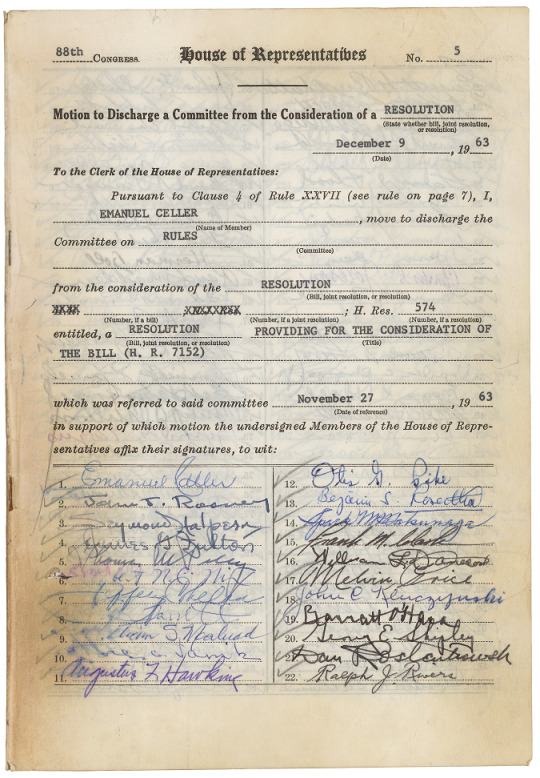
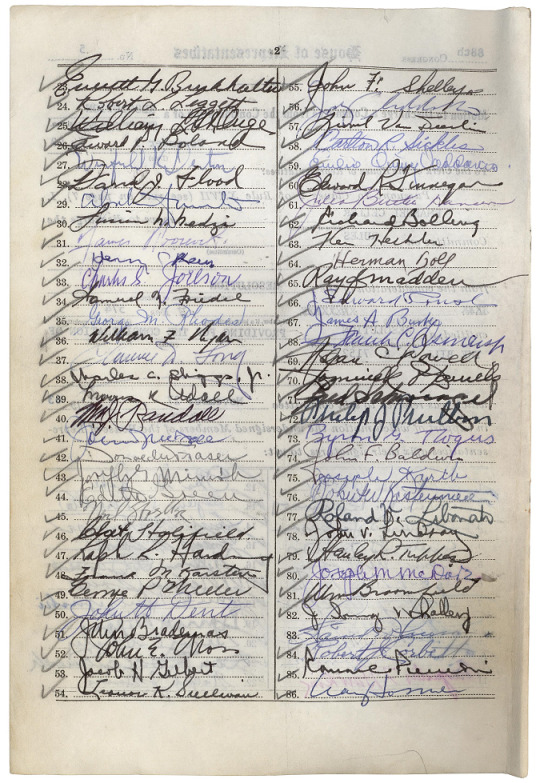
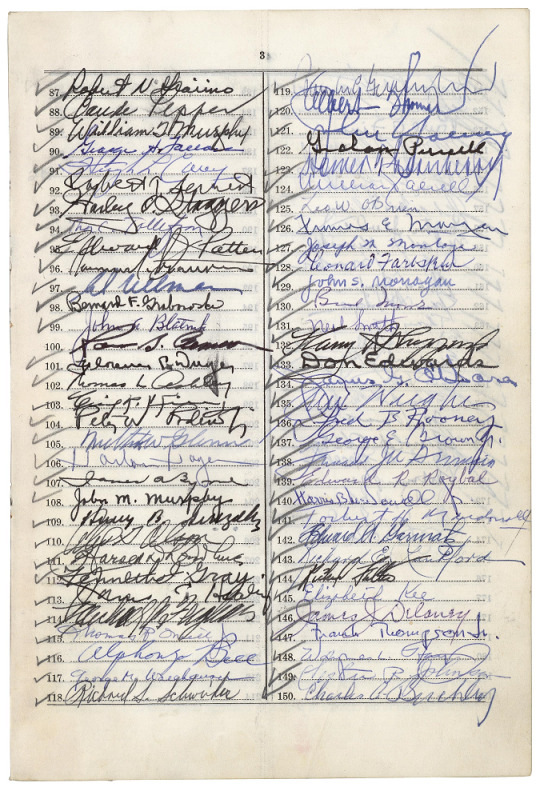

Discharge Petition for H.R. 7152, the Civil Rights Act of 1964
Record Group 233: Records of the U.S. House of RepresentativesSeries: General Records
This item, H.R. 7152, the Civil Rights Act of 1964, faced strong opposition in the House Rules Committee. Howard Smith, Chairman of the committee, refused to schedule hearings for the bill. Emanuel Celler, Chairman of the Judiciary Committee, attempted to use this discharge petition to move the bill out of committee without holding hearings. The petition failed to gain the required majority of Congress (218 signatures), but forced Chairman Smith to schedule hearings.
88th CONGRESS. House of Representatives No. 5 Motion to Discharge a Committee from the Consideration of a RESOLUTION (State whether bill, joint resolution, or resolution) December 9, 1963 To the Clerk of the House of Representatives: Pursuant to Clause 4 of Rule XXVII (see rule on page 7), I EMANUEL CELLER (Name of Member), move to discharge to the Commitee on RULES (Committee) from the consideration of the RESOLUTION; H. Res. 574 entitled, a RESOLUTION PROVIDING FOR THE CONSIDERATION OF THE BILL (H. R. 7152) which was referred to said committee November 27, 1963 in support of which motion the undersigned Members of the House of Representatives affix their signatures, to wit: 1. Emanuel Celler 2. John J. Rooney 3. Seymour Halpern 4. James G Fulton 5. Thomas W Pelly 6. Robt N. C. Nix 7. Jeffery Cohelan 8. W A Barrett 9. William S. Mailiard 10. 11. Augustus F. Hawkins 12. Otis G. Pike 13. Benjamin S Rosenthal 14. Spark M Matsunaga 15. Frank M. Clark 16. William L Dawson 17. Melvin Price 18. John C. Kluczynski 19. Barratt O'Hara 20. George E. Shipley 21. Dan Rostenkowski 22. Ralph J. Rivers[page] 2 23. Everett G. Burkhalter 24. Robert L. Leggett 25. William L St Onge 26. Edward P. Boland 27. Winfield K. Denton 28. David J. Flood 29. 30. Lucian N. Nedzi 31. James Roosevelt 32. Henry C Reuss 33. Charles S. Joelson 34. Samuel N. Friedel 35. George M. Rhodes 36. William F. Ryan 37. Clarence D. Long 38. Charles C. Diggs Jr 39. Morris K. Udall 40. Wm J. Randall 41. 42. Donald M. Fraser 43. Joseph G. Minish 44. Edith Green 45. Neil Staebler 46. 47. Ralph R. Harding 48. Frank M. Karsten 49. 50. John H. Dent 51. John Brademas 52. John E. Moss 53. Jacob H. Gilbert 54. Leonor K. Sullivan 55. John F. Shelley 56. 57. Lionel Van Deerlin 58. Carlton R. Sickles 59. 60. Edward R. Finnegan 61. Julia Butler Hansen 62. Richard Bolling 63. Ken Heckler 64. Herman Toll 65. Ray J Madden 66. J Edward Roush 67. James A. Burke 68. Frank C. Osmers Jr 69. Adam Powell 70. 71. Fred Schwengel 72. Philip J. Philiben 73. Byron G. Rogers 74. John F. Baldwin 75. Joseph Karth 76. 77. Roland V. Libonati 78. John V. Lindsay 79. Stanley R. Tupper 80. Joseph M. McDade 81. Wm Broomfield 82. 83. 84. Robert J Corbett 85. 86. Craig Hosmer87. Robert N. Giaimo 88. Claude Pepper 89. William T Murphy 90. George H. Fallon 91. Hugh L. Carey 92. Robert T. Secrest 93. Harley O. Staggers 94. Thor C. Tollefson 95. Edward J. Patten 96. 97. Al Ullman 98. Bernard F. Grabowski 99. John A. Blatnik 100. 101. Florence P. Dwyer 102. Thomas L. ? 103. 104. Peter W. Rodino 105. Milton W. Glenn 106. Harlan Hagen 107. James A. Byrne 108. John M. Murphy 109. Henry B. Gonzalez 110. Arnold Olson 111. Harold D Donahue 112. Kenneth J. Gray 113. James C. Healey 114. Michael A Feighan 115. Thomas R. O'Neill 116. Alphonzo Bell 117. George M. Wallhauser 118. Richard S. Schweiker 119. 120. Albert Thomas 121. 122. Graham Purcell 123. Homer Thornberry 124. 125. Leo W. O'Brien 126. Thomas E. Morgan 127. Joseph M. Montoya 128. Leonard Farbstein 129. John S. Monagan 130. Brad Morse 131. Neil Smith 132. Harry R. Sheppard 133. Don Edwards 134. James G. O'Hara 135. 136. Fred B. Rooney 137. George E. Brown Jr. 138. 139. Edward R. Roybal 140. Harris. B McDowell jr. 141. Torbert H. McDonall 142. Edward A. Garmatz 143. Richard E. Lankford 144. Richard Fulton 145. Elizabeth Kee 146. James J. Delaney 147. Frank Thompson Jr 148. 149. Lester R. Johnson 150. Charles A. Buckley4 151. Richard T. Hanna 152. James Corman 153. Paul A Fino 154. Harold M. Ryan 155. Martha W. Griffiths 156. Adam E. Konski 157. Chas W. Wilson 158. Michael J. Kewan 160. Alex Brooks 161. Clark W. Thompson 162. John D. Gringell [?] 163. Thomas P. Gill 164. Edna F. Kelly 165. Eugene J. Keogh 166 John. B. Duncan 167. Elmer J. Dolland 168. Joe Caul 169. Arnold Olsen 170. Monte B. Fascell [?] 171. [not deciphered] 172. J. Dulek 173. Joe W. [undeciphered] 174. J. J. Pickle [Numbers 175 through 214 are blank]
39 notes
·
View notes
Note
2 and a half weeks until JC passes Cactus Jack!
It took me a little bit to figure out what you were referencing, but yes, Jimmy Carter will pass John Nance Garner as the longest-living President or Vice President in American history on September 18th. And if he is still with us on October 1st, Carter will be the first President or Vice President in American history to celebrate their 99th birthday.
And since I'm a huge dork who finds this stuff interesting, here's the big, complete list of longest-living to shortest-living Presidents and Vice Presidents in American history: (Presidents are in bold text, Vice Presidents are in italics, and those who served as both POTUS and VP are in bold italics.) John Nance Garner: 98 years, 351 days Jimmy Carter: 98 years, 337 days (As of Sept. 3, 2023) Levi P. Morton: 96 years, 0 days George H.W. Bush: 94 years, 171 days Gerald R. Ford: 93 years, 165 days Ronald Reagan: 93 years, 120 days Walter Mondale: 93 years, 81 days John Adams: 90 years, 247 days Herbert Hoover: 90 years, 71 days Harry S. Truman: 88 years, 232 days Charles G. Dawes: 85 years, 239 days James Madison: 85 years, 104 days Thomas Jefferson: 83 years, 82 days Dick Cheney: 82 years, 216 days (As of Sept. 3, 2023) Hannibal Hamlin: 81 years, 311 days Richard Nixon: 81 years, 104 days Joe Biden: 80 years, 287 days (As of Sept. 3, 2023) John Quincy Adams: 80 years, 227 days Aaron Burr: 80 years, 220 days Martin Van Buren: 79 years, 231 days Adlai E. Stevenson: 78 years, 234 days Dwight D. Eisenhower: 78 years, 165 days Alben W. Barkley: 78 years, 157 days Andrew Jackson: 78 years, 85 days Spiro Agnew: 77 years, 261 days Donald Trump: 77 years, 81 days (As of Sept. 3, 2023) George W. Bush: 77 years, 59 days (As of Sept. 3, 2023) Henry A. Wallace: 77 years, 42 days James Buchanan: 77 years, 39 days Bill Clinton: 77 years, 15 days (As of Sept. 3, 2023) Dan Quayle: 76 years, 211 days (As of Sept. 3, 2023) Charles Curtis: 76 years, 14 days Al Gore: 75 years, 156 days (As of Sept. 3, 2023) Millard Fillmore: 74 years, 60 days James Monroe: 73 years, 67 days George Clinton: 72 years, 268 days George M. Dallas: 72 years, 174 days William Howard Taft: 72 years, 174 days John Tyler: 71 years, 295 days Grover Cleveland: 71 years, 98 days Thomas R. Marshall: 71 years, 79 days Nelson Rockefeller: 70 years, 202 days Elbridge Gerry: 70 years, 129 days Rutherford B. Hayes: 70 years, 105 days Richard M. Johnson: 70 years, 33 days William Henry Harrison: 68 years, 54 days John C. Calhoun: 68 years, 13 days William A. Wheeler: 67 years, 339 days George Washington: 67 years, 295 days Benjamin Harrison: 67 years, 205 days Woodrow Wilson: 67 years, 36 days William R. King: 67 years, 11 days Hubert H. Humphrey: 66 years, 231 days Andrew Johnson: 66 years, 214 days Thomas A. Hendricks: 66 years, 79 days Charles W. Fairbanks: 66 years, 24 days Zachary Taylor: 65 years, 227 days Franklin Pierce: 64 years, 319 days Lyndon B. Johnson: 64 years, 148 days Mike Pence: 64 years, 88 days (As of Sept. 3, 2023) Henry Wilson: 63 years, 279 days Ulysses S. Grant: 63 years, 87 days Franklin D. Roosevelt: 63 years, 72 days Barack Obama: 62 years, 30 days (As of Sept. 3, 2023) Schuyler Colfax: 61 years, 296 days Calvin Coolidge: 60 years, 185 days Theodore Roosevelt: 60 years, 71 days Kamala Harris: 58 years, 318 days (As of Sept. 3, 2023) William McKinley: 58 years, 228 days Warren G. Harding: 57 years, 273 days Chester A. Arthur: 57 years, 44 days James S. Sherman: 57 years, 6 days Abraham Lincoln: 56 years, 62 days Garret A. Hobart: 55 years, 171 days John C. Breckinridge: 54 years, 116 days James K. Polk: 53 years, 225 days Daniel D. Tompkins: 50 years, 355 days James Garfield: 49 years, 304 days John F. Kennedy: 46 years, 177 days
#History#Presidents#Vice Presidents#Longest-living Presidents and Vice Presidents#Presidential Data#Presidential Statistics#Presidential Facts#POTUS#VP#Jimmy Carter#President Carter#John Nance Garner#Vice President Garner
57 notes
·
View notes
Text




i knew a girl just like you, she was vain just like you

Zahara Kumar - Man-Eater
[ G o t h G a l o r e K i t R a t i n g - 4 / 1 0 ]

CC Links: Hair* Eyebrows[105] Antennae Ears Skin[B] Lashes Piercings[1][2] Nails Rings Spike Garter Fishnets Socks Shoes Tattoos*
*=TSR/CURSEFORGE WARNING
cc by: @simcelebrity00 @sims3melancholic @ssspringroll @saruin @northernsiberiawinds @nsves @dream-girl @pralinesims @trillyke @serenity-cc @jius-sims @atomiclightcc poses by @helgatisha
reshade preset by @shinybacon
#black simmer#create a sim#ts4#ts4 simblr#s4 simblr#sims 4 lookbook#lookbook#sims lookbook#ts4 lookbook#black sims#my sims#show us your sims#sim 4 cas#simblog#simblr#simmer#sims#sims 4 cas#sims 4 cc#sims 4 community#goth galore#Spotify#seanster
31 notes
·
View notes
Text
6 - 21/06/2025

wieiad — 1.90 — free day
breakfast (7:00am): oatmeal with peach yogurt and one banana; one coffee pod and one barley pod
morning snack (10:30am): chocolate chips cookies and one banana
lunch (1:30pm): pasta with homemade pesto and one salted caramel bignè
afternoon snack (4:15pm / 7:40pm): one slice of chocolate cake; one coffee / one aperol spitz cocktail
dinner (8:40pm): KFC Squid Game burger with medium fries; one tall glass of pepsi zero
dessert (9:30pm): pancakes with chocolate and oreo crumbs
[B/P - L - D - E - SH]
[cigarettes: 17] [vape: 105 drags]
[TIPs: 1] [TAB: yes] [steps: 11k]

random pics I was able to take








daily log
today was a good day !! my gf made the best pesto !!! i loved it sm she's amazing !!! and we went to pride !!!! and it was so much fun !!! i got to kiss my gf in public and hold hands and it gave me so much hope for myself and for my future !!!! hell yeah !!!! seeing all the people there gave me so much happiness idk how to describe it !!!
i feel like i overate but fuck that i had fun !!! that's all i should think of !!!!
gn !!! am happy !!! :DD
#ed recovery#pro recovery#— daily food log#cw food#food log#recovery is possible#wieiad#what i eat in a day#ed wieiad
4 notes
·
View notes
Text

F.4.1 What is wrong with a “homesteading” theory of property?
So how do “anarcho”-capitalists justify property? Looking at Murray Rothbard, we find that he proposes a “homesteading theory of property”. In this theory it is argued that property comes from occupancy and mixing labour with natural resources (which are assumed to be unowned). Thus the world is transformed into private property, for “title to an unowned resource (such as land) comes properly only from the expenditure of labour to transform that resource into use.” [The Ethics of Liberty, p. 63]
His theory, it should be stressed, has its roots in the same Lockean tradition as Robert Nozick’s (which we critiqued in section B.3.4). Like Locke, Rothbard paints a conceptual history of individuals and families forging a home in the wilderness by the sweat of their labour (it is tempting to rename his theory the “immaculate conception of property” as his conceptual theory is so at odds with actual historical fact). His one innovation (if it can be called that) was to deny even the rhetorical importance of what is often termed the Lockean Proviso, namely the notion that common resources can be appropriated only if there is enough for others to do likewise. As we noted in section E.4.2 this was because it could lead (horror of horrors!) to the outlawry of all private property.
Sadly for Rothbard, his “homesteading” theory of property was refuted by Proudhon in What is Property? in 1840 (along with many other justifications of property). Proudhon rightly argued that “if the liberty of man is sacred, it is equally sacred in all individuals; that, if it needs property for its objective action, that is, for its life, the appropriation of material is equally necessary for all … Does it not follow that if one individual cannot prevent another … from appropriating an amount of material equal to his own, no more can he prevent individuals to come.” And if all the available resources are appropriated, and the owner “draws boundaries, fences himself in … Here, then, is a piece of land upon which, henceforth, no one has a right to step, save the proprietor and his friends … Let [this]… multiply, and soon the people … will have nowhere to rest, no place to shelter, no ground to till. They will die at the proprietor’s door, on the edge of that property which was their birthright.” [What is Property?, pp. 84–85 and p. 118]
Proudhon’s genius lay in turning apologies for private property against it by treating them as absolute and universal as its apologists treated property itself. To claims like Rothbard’s that property was a natural right, he explained that the essence of such rights was their universality and that private property ensured that this right could not be extended to all. To claims that labour created property, he simply noted that private property ensured that most people have no property to labour on and so the outcome of that labour was owned by those who did. As for occupancy, he simply noted that most owners do not occupancy all the property they own while those who do use it do not own it. In such circumstances, how can occupancy justify property when property excludes occupancy? Proudhon showed that the defenders of property had to choose between self-interest and principle, between hypocrisy and logic.
Rothbard picks the former over the latter and his theory is simply a rationale for a specific class based property rights system (”[w]e who belong to the proletaire class, property excommunicates us!” [P-J Proudhon, Op. Cit., p. 105]). As Rothbard himself admitted in respect to the aftermath of slavery and serfdom, not having access to the means of life places one the position of unjust dependency on those who do and so private property creates economic power as much under his beloved capitalism as it did in post-serfdom (see section F.1). Thus, Rothbard’s account, for all its intuitive appeal, ends up justifying capitalist and landlord domination and ensures that the vast majority of the population experience property as theft and despotism rather than as a source of liberty and empowerment (which possession gives).
It also seems strange that while (correctly) attacking social contract theories of the state as invalid (because “no past generation can bind later generations” [Op. Cit., p. 145]) he fails to see he is doing exactly that with his support of private property (similarly, Ayn Rand argued that ”[a]ny alleged ‘right’ of one man, which necessitates the violation of the right of another, is not and cannot be a right” but, obviously, appropriating land does violate the rights of others to walk, use or appropriate that land [Capitalism: The Unknown Ideal, p. 325]). Due to his support for appropriation and inheritance, Rothbard is clearly ensuring that future generations are not born as free as the first settlers were (after all, they cannot appropriate any land, it is all taken!). If future generations cannot be bound by past ones, this applies equally to resources and property rights. Something anarchists have long realised — there is no defensible reason why those who first acquired property should control its use and exclude future generations.
Even if we take Rothbard’s theory at face value we find numerous problems with it. If title to unowned resources comes via the “expenditure of labour” on it, how can rivers, lakes and the oceans be appropriated? The banks of the rivers can be transformed, but can the river itself? How can you mix your labour with water? “Anarcho”-capitalists usually blame pollution on the fact that rivers, oceans, and so forth are unowned but as we discussed in section E.4, Rothbard provided no coherent argument for resolving this problem nor the issue of environmental externalities like pollution it was meant to solve (in fact, he ended up providing polluters with sufficient apologetics to allow them to continue destroying the planet).
Then there is the question of what equates to “mixing” labour. Does fencing in land mean you have “mixed labour” with it? Rothbard argues that this is not the case (he expresses opposition to “arbitrary claims”). He notes that it is not the case that “the first discoverer … could properly lay claim to” a piece of land by “laying out a boundary for the area.” He thinks that “their claim would still be no more than the boundary itself, and not to any of the land within, for only the boundary will have been transformed and used by men” However, if the boundary is private property and the owner refuses others permission to cross it, then the enclosed land is inaccessible to others! If an “enterprising” right-“libertarian” builds a fence around the only oasis in a desert and refuses permission to cross it to travellers unless they pay his price (which is everything they own) then the person has appropriated the oasis without “transforming” it by his labour. The travellers have the choice of paying the price or dying (and any oasis owner is well within his rights letting them die). Given Rothbard’s comments, it is probable that he could claim that such a boundary is null and void as it allows “arbitrary” claims — although this position is not at all clear. After all, the fence builder has transformed the boundary and “unrestricted” property rights is what the right-“libertarian” is all about. One thing is true, if the oasis became private property by some means then refusing water to travellers would be fine as “the owner is scarcely being ‘coercive’; in fact he is supplying a vital service, and should have the right to refuse a sale or charge whatever the customers will pay. The situation may be unfortunate for the customers, as are many situations in life.” [Op. Cit., p. 50f and p. 221] That the owner is providing “a vital service” only because he has expropriated the common heritage of humanity is as lost on Rothbard as is the obvious economic power that this situation creates.
And, of course, Rothbard ignores the fact of economic power — a transnational corporation can “transform” far more virgin resources in a day by hiring workers than a family could in a year. A transnational “mixing” the labour it has bought from its wage slaves with the land does not spring into mind reading Rothbard’s account of property but in the real world that is what happens. This is, perhaps, unsurprising as the whole point of Locke’s theory was to justify the appropriation of the product of other people’s labour by their employer.
Which is another problem with Rothbard’s account. It is completely ahistoric (and so, as we noted above, is more like an “immaculate conception of property”). He has transported “capitalist man” into the dawn of time and constructed a history of property based upon what he is trying to justify. He ignores the awkward historic fact that land was held in common for millennium and that the notion of “mixing” labour to enclose it was basically invented to justify the expropriation of land from the general population (and from native populations) by the rich. What is interesting to note, though, is that the actual experience of life on the US frontier (the historic example Rothbard seems to want to claim) was far from the individualistic framework he builds upon it and (ironically enough) it was destroyed by the development of capitalism.
As Murray Bookchin notes, in rural areas there “developed a modest subsistence agriculture that allowed them to be almost wholly self-sufficient and required little, if any, currency.” The economy was rooted in barter, with farmers trading surpluses with nearby artisans. This pre-capitalist economy meant people enjoyed “freedom from servitude to others” and “fostered” a “sturdy willingness to defend [their] independence from outside commercial interlopers. This condition of near-autarchy, however, was not individualistic; rather it made for strong community interdependence … In fact, the independence that the New England yeomanry enjoyed was itself a function of the co-operative social base from which it emerged. To barter home-grown goods and objects, to share tools and implements, to engage in common labour during harvesting time in a system of mutual aid, indeed, to help new-comers in barn-raising, corn-husking, log-rolling, and the like, was the indispensable cement that bound scattered farmsteads into a united community.” Bookchin quotes David P. Szatmary (author of a book on Shay’ Rebellion) stating that it was a society based upon “co-operative, community orientated interchanges” and not a “basically competitive society.” [The Third Revolution, vol. 1, p. 233]
Into this non-capitalist society came capitalist elements. Market forces and economic power soon resulted in the transformation of this society. Merchants asked for payment in specie (gold or silver coin), which the farmers did not have. In addition, money was required to pay taxes (taxation has always been a key way in which the state encouraged a transformation towards capitalism as money could only be made by hiring oneself to those who had it). The farmers “were now cajoled by local shopkeepers” to “make all their payments and meet all their debts in money rather than barter. Since the farmers lacked money, the shopkeepers granted them short-term credit for their purchases. In time, many farmers became significantly indebted and could not pay off what they owed, least of all in specie.” The creditors turned to the courts and many the homesteaders were dispossessed of their land and goods to pay their debts. In response Shay’s rebellion started as the “urban commercial elites adamantly resisted [all] peaceful petitions” while the “state legislators also turned a deaf ear” as they were heavily influenced by these same elites. This rebellion was an important factor in the centralisation of state power in America to ensure that popular input and control over government were marginalised and that the wealthy elite and their property rights were protected against the many (“Elite and well-to-do sectors of the population mobilised in great force to support an instrument that clearly benefited them at the expense of the backcountry agrarians and urban poor.”) [Bookchin, Op. Cit., p. 234, p. 235 and p. 243]). Thus the homestead system was, ironically, undermined and destroyed by the rise of capitalism (aided, as usual, by a state run by and for the rich).
So while Rothbard’s theory as a certain appeal (reinforced by watching too many Westerns, we imagine) it fails to justify the “unrestricted” property rights theory (and the theory of freedom Rothbard derives from it). All it does is to end up justifying capitalist and landlord domination (which is what it was intended to do).
#homesteading#private property#ownership#faq#anarchy faq#revolution#anarchism#daily posts#communism#anti capitalist#anti capitalism#late stage capitalism#organization#grassroots#grass roots#anarchists#libraries#leftism#social issues#economy#economics#climate change#climate crisis#climate#ecology#anarchy works#environmentalism#environment#solarpunk#anti colonialism
12 notes
·
View notes
Text
Okay, so I finally got around to all the responses given for the Random Whump Questions google form I made! Everything is ranked from highest to lowest in terms of what was picked, and the number beside them is how many people chose that option:)
Also, to make sure it's not longer than it needs to be, I'm going to do the open ended questions in a separate post:) Let me know if you'd like to be tagged for that!
One more thing to keep in mind. The 'custom answers' section is where only one person has brought it up. If multiple people have said the same thing, then it will be included in the main answers :)
-
Question 1. When did you first discover whump as a term?
A. 15 - 17 (106) B. 11 - 14 (105) C. 20 - 25 (42) D. 18 - 19 (39) E. 26 - 30 (21) F. -10 (4) G. 36 - 39 (4) H. 31 - 35 (3)

-
Question 2.
A. Absolutely not (135) B. Some of them do but I prefer to keep it to myself (127) C. I don't try to hide it but not many people know anyway (42) D. Most, if not all of them know - I'm very open about it (10) E. One person knows (4) F. Friends know, family don't (2)
Custom answers: I'm not secretive but I don't explain it because it's hard to, I've never said it but you only need to look at me to know.

-
Question 4. Biggest pet peeve when it comes to whump in media?
A. Whumpee miraculously recovers as if they didn't just break three vital bones in their body and get stabbed by the enemy (204) B. Skipping over it and going straight to recovery (165) C. Changes POV's right as it's getting juicy (154) D. Whumpee is too stoic and unphased by what happened (130) E. Too comedic/lighthearted (128) F. Main character(s) die rather than living with what they've done/what happened (127) G. Too much comfort and not enough hurt (80) H. The recovery/captivity is far too unrealistic (77) I. Too much hurt and not enough comfort (62) J. Whumpee is a massive wuss (56) K. All of the above (23) L. The recovery/captivity is too realistic (20) M. Too heavy/serious (16) N. Whumpee is unattractive/not cute enough to me (2) O. Wrong characters are whumped/favourite characters are ignored (2)
Custom written: Obvious medical errors, turns out it was all "just a nightmare!", Caretaker's wellbeing is ignored, Whumpee is rescued right before the whump was about to start, Caretaker never figures out what happened and it's never brought up again, no women, never goes as badly as I want, not enough from Whumpee's POV.
Custom written #2: Whumpee is infantilised during their recovery, no trauma/trauma is overlooked, aftermath/recovery is ignored by a timeskip, Whumpee has no personality apart from being the one who deserves pity for being white and pretty and sweet, caretaker saves the day and it's never brought up again.
Custom written #3: Caretaker saves the day and Whumpee is the perfect victim and there's no conflict ever again, too much emphasis on physical pain rather than emotional, whumper wants love from their whumpees, recovery is too fast and it involves sexual/romantic stuff.
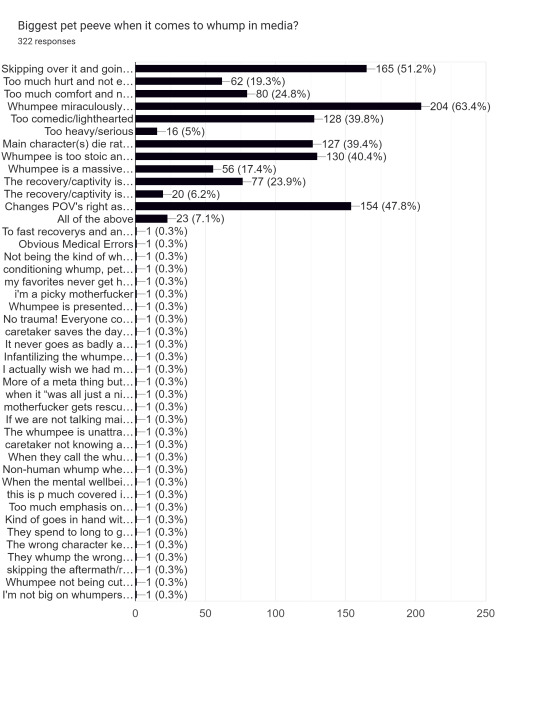
-
Question 5. Best thing a whumpee can say to give you whumperflies?
A. "Please- please, no more." (146) B. "It hurts." (142) C. "Please don't leave me." (109) D. "Don't hurt them." (94) E. "Get the hell away from me." (85) F. "I just want to be good." (81) G. "You promised." (71) H. "Am I not enough?" (69) I. "I thought... I thought it was over." (50) J. "You came back!" (49) K. "I was so scared." (43) L. "You will not break me." (36) M. All of the above (19) N. Description over dialogue/I prefer whumpees that are too scared to talk (6) O. Begging (2) P. "I'm fine." (2) Q. "I can't take it anymore." (2)
Custom answers: "Go away" | "It's all my fault, I'm sorry" | "don't touch me!" | "I'm sorry, I won't do it again, I promise" | "don't look at me" | "I don't want you to see me like this" | "fuck you" | just a heartbroken "why?" | "it's fine!"
Custom answers #2: "Nobody is coming..." | "i'm not the same person I was before" | "is this real?" | "I don't want to die" | "why are you helping me?" | Repeating "i'm okay" to themselves while trying not to cry.

-
Question 7. Best thing a whumper can say to give you whumperflies?
A. "I wonder how long it'll take to break you." (120) B. "Surely you can take a little more than that, can't you?" (111) C. "Tell me what I need to know and it'll all be over." (111) D. "You're being so good." (107) E. "You're so adorable when you cry." (98) F. "You're mine." (79) G. "Which finger should I crush this time?" (78) H. "I think if you were really sorry, you'd __" (63) I. "This is your home now." (57) J. "At least try to show a little enthusiasm." (49) K. "Please forgive me." (47) L. "You live to please me." (41) M. All of the above (15) N. Prefer no whumpers (7) O. Silent whumpers (3)
Custom answers: "Everything you touch dies." | "I have your whumpee." | "You wanna see something weird/interesting/cool?" | "Get some rest, darling. We'll pick this up again tomorrow." | "Just what do you think you're doing?" | "Don't worry. I'll take good care of you."
Custom answers #2: Petnames | "It's not personal." | "Nobody's coming for you. Give up." | "This is all your fault." | "You shouldn't have done that, darling." | "You'll be begging soon." | "Maybe some pain/time out/etc. will change your mind." | "It's you or them." | "Go ahead, try to run."
Custom answers #3: "Do it or I'll hurt them." | "This is for your own good." | "This will only hurt a pinch." | "Why do you have to ruin everything?" | "The more you scream, the more I have to hurt you." | "It's for science, Whumpee." | "I truly am sorry about this." | "I love you so, so much. I want to taste you..." | "Good boy."
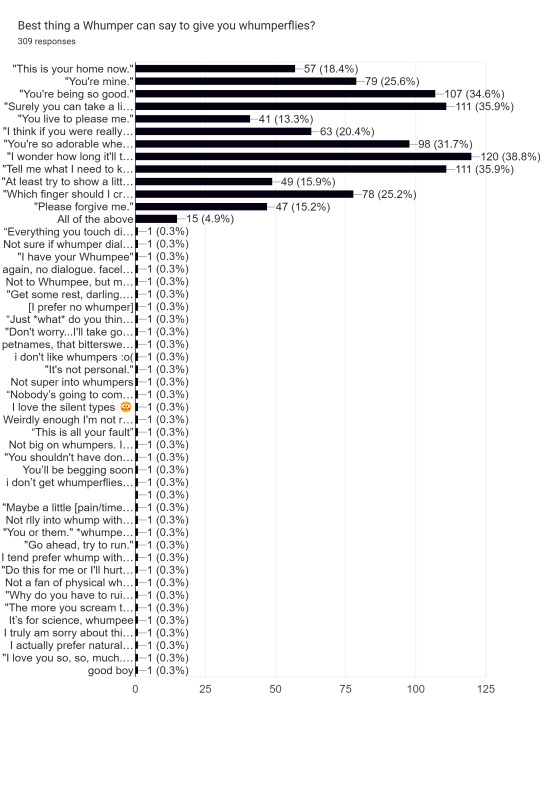
-
Question 8. Best thing a Caretaker can say to give you whumperflies?
A. "I got you." (180) B. "Breathe. Just breathe." (170) C. "What did they do to you." (154) D. "Hey, I'm here, okay?" (152) E. "Lie down, okay?" (107) F. "I'm gonna get us out of here." (107) G. "When was the last time they fed you?" (97) H. "Lay a hand on them and see what happens." (88) I. "Don't hurt them." (83) J. "I'm sorry but this is in your best interest." (66) K. "I will not rest until I find who did this." (41) L. "Don't cry." (32) M. All of the above (26) N. Any sort of medical talk (2) O. No caretakers (2)
Custom answers: "Don't touch them!" | Pet names in general | "Just relax. It's all over." | "Don't fucking touch them." | "It's not your fault." | "Hold still" while tending to wounds | "Almost done | Just hold on." | "Hey... not so fast." | "Just look at me, okay?" and then proceeds to gently explain what the medical procedure entails | "You're safe now." | "Please believe me?"
Custom answers #2: "May I see? I promise I won't hurt you." | "Whoa, hey, calm down. I'm not gonna hurt you." | "Shh, you're safe now. It's okay. I'm not leaving." | "Who did this to you?" | "Take this, you'll feel better." | "Shh, I know it hurts" to a squirming whumpee | Anything as long as there's physical touch to go with it | "Stay with me, okay?" | "You need to stay awake for me." | "Leave them alone!"
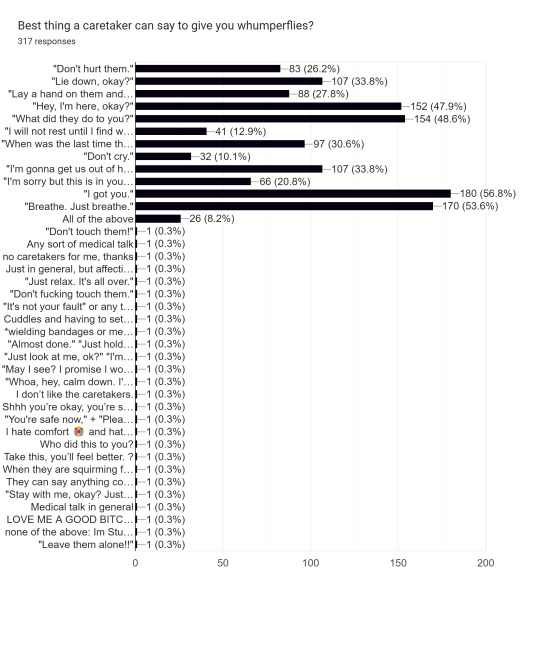
-
Question 9. What role do you think you'd play in a whump story?
A. Whumpee (87) B. Caretaker (52) C. Side character (44) D. Caretaker-turned-whumpee (32) E. Whumpee-turned-caretaker (22) F. Whumper (16) G. Whumpee-turned-whumper (14) H. Whumper-turned-whumpee (11) I. Whumper-turned-caretaker (10) J. Caretaker-turned-whumper (8) K. Caretaker or whumpee (6) L. Carewhumper (3) M. None/I don't insert myself into scenarios (2)
Custom answers: Narrator, all of the above depending on my mood, side character.
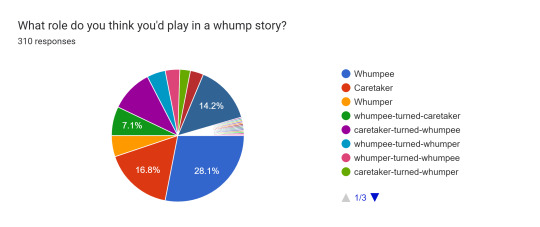
-
Question 11. Favourite place to consume whump? (not including movies/tv shows/games/etc)
A. Tumblr (294) B. AO3 (212) C. Pinterest (62) D. Fanfiction.net (23) E. DeviantArt (8) F. Wattpad (4) G. My brain (4) H. All of the above (3) I. Youtube (3) J. Character.AI (2) K. Discord (2) L. My brain (2) M. Twitter (2)
Custom answers: Sketch book, google,
Other notes: Someone also gave @whumplovers-collaborate a mention, saying they've been on that server for over a year and that it's amazing.
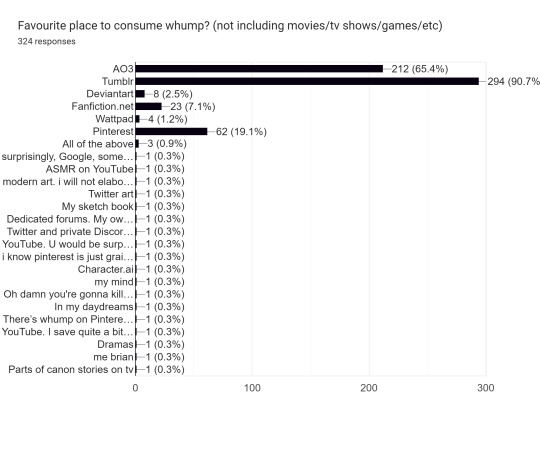
-
Question 12. Pick a whumpy anime out of the ones I've watched (so far)
A. Castlevania (51) B. Black Butler (43) C. Bungou Stray Dogs (43) D. Banana Fish (35) E. Vanitas No Carte (19) F. Black Bullet (5)

-
Question 14. How old does a whumpee need to be to be considered an "older whumpee"?
A. 40+ (127) B. 34 - 37 (68) C. 30 - 33 (51) D. 38 - 39 (38) E. 26 - 29 (18) F. 22 - 25 (2) G. 18 - 21 (0)
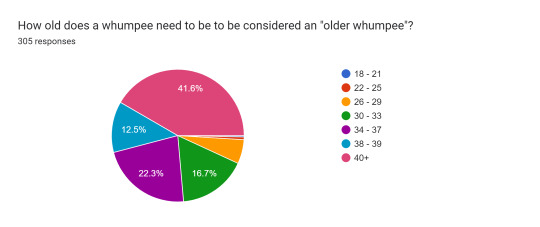
-
Question 15. Pick a character that I think needs to be whumped more.
A. Link (The Legend Of Zelda) (96) B. Tony Stark (The Avengers/Iron Man) (64) C. Vanitas & Noe (Vanitas No Carte) (47) D. Joel Miller (The Last Of Us) (45) E. Hosea Matthews (Red Dead Redemption 2) (5)
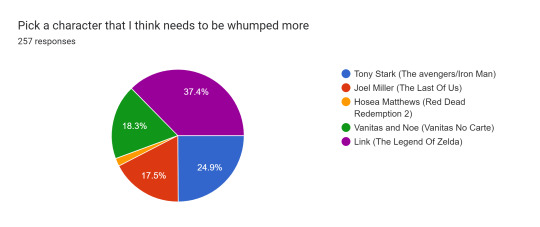
-
Question 16. Do you prefer hystorical whump or modern whump?
A. Modern (220) B. Hystorical (82)

-
Question 17. Do you prefer hurt or comfort?
A. A healthy combination of both (163) B. A little bit of comfort, lots of hurt (81) C. Hurt (44) D. A little hurt, lots of comfort (28) E. Comfort (8)

-
Question 19. Favourite species to whump?
A. Human (290) B. Immortal (118) C. Vampire (105) D. Demon/angel (87) E. Werewolf (57) F. Robot/android/cyborg (54) G. God/deity (49) H. Birdpeople (48) I. Merfolk (44) J. Tiny (38) K. Catpeople (26) L. Alien (19) M. All (16) N. Humans with inhuman/magical abilities (5) O. Giant (2) P. Elf (2) Q. Lab subjects (2) R. Species isn't important (2)
Custom answers: Shapeshifter, hybrics, faefolk, winged whumpees, dhampir, superheros, dwarves, mobian.
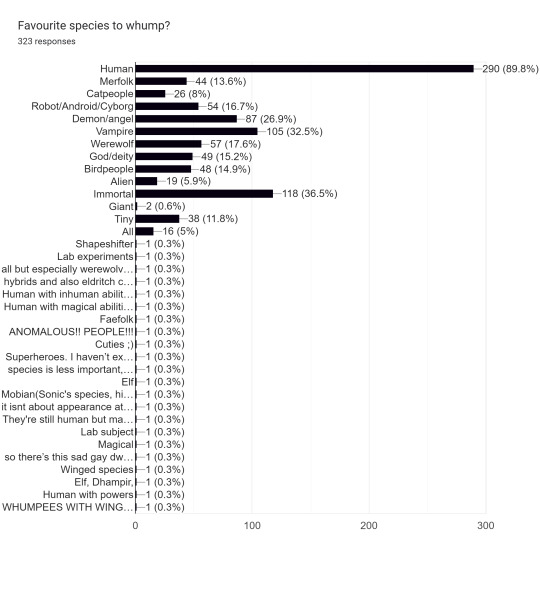
-
Question 20. Pick something to restrain your whumpee with.
A. Chains (104) B. Rope (101) C. Handcuffs (38) D. Zipties (31) E. Your belt (18) F. A piece of their own clothing (18) G. Your tie (6)
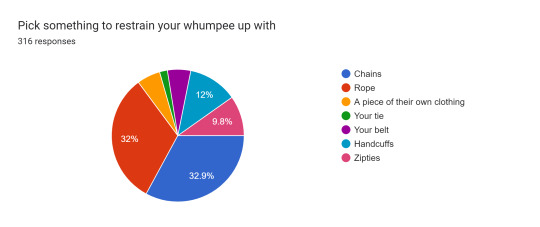
-
Question 22: Your whumpee bites you. What do you do?
A. Put a muzzle on them. You're not mad, but you need to keep yourself safe (119) B. Beat them until they learn their lesson (82) C. Have a rational conversation with them once they've calmed down about why it's wrong and how to stop it from happening again (61) D. Get checked for some kind of desease. Who knows what they've been carrying (25) E. Ignore it and hope it doesn't happen again (8)
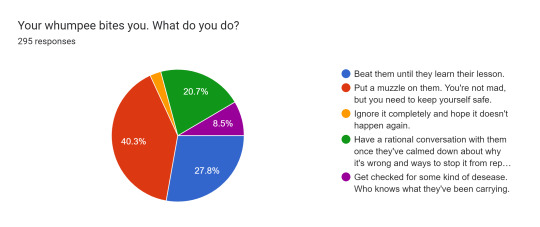
-
Question 23. A whumpee shows up at your door, terrified and scared. They beg for your help. What do you do?
A. Let them in and give them some food. You can worry about what you're gonna do with them later on (273) B. Keep them prisoner. Whump their to your heart's content (31) C. Slam the door in their face (4)
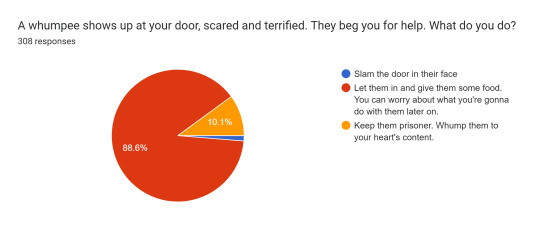
-
Taglist: @dismemberment-on-a-tuesday-night @let-the-whump-commence @pigeonwhumps @rule-masochism @whumperofworlds @whump-space @wollemi-whump
70 notes
·
View notes